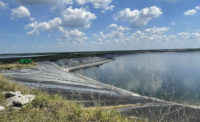Gov. Andrew Cuomo has announced today, Oct. 29, that the Tappan Zee Bridge (TZB) closed at 4 p.m. and both the Hugh Carey and Holland tunnels closed at 2 p.m. as Hurricane Sandy bore down on the New York City region with storm gusts of up to 80 to 85 miles per hour.
NYC bridges are "quickly becoming unsafe," Cuomo said in a statement. However, they will remain open to emergency vehicles and personnel. Other bridges to be closed include the Throgs Neck, Bronx-Whitestone, Verrazano-Narrows, Henry Hudson, Marine Parkway-Gil Hodges Memorial, Cross Bay Veterans Memorial, and George Washington. The Staten Island crossings and Robert F. Kennedy/Triborough Bridge will remain open as long as possible consistent with safety, but closures could occur imminently, he says. Hudson River bridges north of the TZB were not closed at press time.
The Metropolitan Transportation Authority has suspended subway and bus services as well as Metro-North and Long Island Rail Road rail lines until further notice.
The New York City Dept. of Buildings (DOB) suspended all exterior buildings work on Saturday at 5 p.m. ahead of the storm and until further notice. The agency excluded work related to safeguarding sites or to damage repair related to the storm, however.
Industry firms in the tri-state area were battening down the hatches on Friday, Oct. 26, and through the weekend in preparation for Hurricane Sandy, whose strong winds are currently pounding the region. The New York City Dept. of Buildings (DOB) suspended all exterior buildings work on Saturday at 5 p.m. ahead of the storm and until further notice. The agency excluded work related to safeguarding sites or to damage repair related to the storm, however.
Many large firms have long-had crisis contingency plans in place but as major weather systems—including Hurricane Irene last year—have hit the region hard this decade, those plans have evolved further and become more extensive.
"From our past experiences, we have programs built around events, whether they are storms, earthquakes" or other natural occurrences that could affect work sites, says Cindy DePrater, vice president of Environment, Health & Safety at Turner Construction Co., New York. "With the first indication of when a tropical storm or [other adverse weather] has the potential to take place, we start our early preparedness phase."
For Turner, this involves gathering the latest storm data from official sources, putting projects in the path of the danger zone on notice, and notifying insurance carriers "so that they can start their readiness reviews," she says. The company also has a storm emergency team that includes owners, project managers, superintendents, and key subcontractors such as the mechanical, electrical and plumbing subcontractors, to respond to individual site issues.
Turner makes extensive use of its intranet Web portal, keeping employees updated with information including company contacts and local evacuation routes, as well as for holding storm update meetings with project team members and owners. It recently began using a third-party system that provides a live operator who will input information on the crisis into a system and email that data to a pre-set list of emergency contacts.
Early on, both the business unit managers that may be affected by a storm and those that are not likely to are connected by phone or email so that the latter can help the former if necessary, she says.




